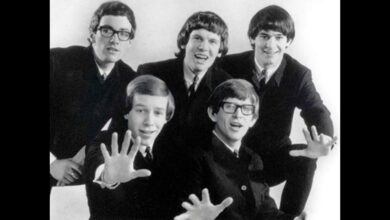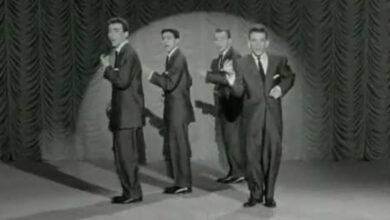The Hollies’ “Carrie Anne” Blends Pop Sophistication with Island Flair to Redefine British Rock in 1967
Released in May 1967, The Hollies’ “Carrie Anne” marked a bold shift for the British pop-rock group, intertwining tight vocal harmonies with unexpected Caribbean rhythms to create one of the most distinct and memorable singles of their career. Arriving at the height of the Summer of Love, the track reached number three on the UK Singles Chart and cracked the Top 10 in several countries, including the United States. Its unique blend of pop melody and steel drum accents helped it stand out in a year crowded with musical experimentation, and it remains one of the defining songs of The Hollies’ golden period.
Formed in Manchester in the early 1960s, The Hollies were built around the vocal partnership of Allan Clarke and Graham Nash. While many of their contemporaries leaned into blues roots or Merseybeat, The Hollies distinguished themselves with radiant harmonies and a knack for crafting crisp, radio-ready hits. By the mid-60s, they had become one of the most consistent hitmakers in the UK, rivaling even The Beatles and The Rolling Stones in chart presence, though often with a more polished, pop-oriented sound. “Carrie Anne” was the first major release to feature their songwriting credited as Clarke-Hicks-Nash, signaling a creative turning point within the band.
The inspiration behind “Carrie Anne” was drawn from a very real—and very famous—figure of the 1960s British music scene: Marianne Faithfull. Though the song’s title subtly disguises her identity, the band later admitted the lyrics were a veiled tribute to her allure and emotional unavailability, capturing the aching longing of youthful infatuation. In its lyrical simplicity lies a universal sentiment—the pain of admiration without fulfillment—wrapped in a deceptively cheerful melody.
From a production standpoint, “Carrie Anne” was one of The Hollies’ most adventurous tracks to date. Produced by Ron Richards at EMI’s Abbey Road Studios, the song opens with jangly guitars and a buoyant, ascending vocal line that immediately locks the listener into its cheerful mood. But the real surprise comes in the instrumental break: a steel drum solo, one of the first uses of the instrument in mainstream British rock. Played by Trinidadian musician Ralph Richardson, the solo added a tropical, playful texture that was virtually unheard of in British pop at the time and reflected the growing influence of global sounds on Western music.
The single was met with enthusiasm upon release, becoming a major hit in the UK and performing respectably in the US, where it reached number nine on the Billboard Hot 100. It also charted in Australia, Canada, and several European countries. Critics praised its harmonic strength and fresh sound, though some were initially puzzled by the Caribbean influences. Fans, however, embraced it, and the song quickly became a staple of the band’s live performances.
“Carrie Anne” arrived during a period of tremendous innovation and genre-blending in popular music. The Beatles had just released “Sgt. Pepper’s Lonely Hearts Club Band,” and artists were increasingly willing to step beyond the confines of traditional pop-rock. The Hollies’ decision to incorporate steel drums—then associated mainly with calypso or Caribbean folk music—was not just a sonic experiment but a cultural bridge, widening the palette of acceptable sounds in British rock and pop.
For The Hollies, the song reinforced their reputation as melodic craftsmen but also demonstrated a new willingness to take risks. It opened creative doors that would eventually lead to more introspective and complex recordings like “King Midas in Reverse” and “Butterfly.” For Graham Nash in particular, “Carrie Anne” was part of his gradual shift toward more personal and poetic songwriting—a journey that would eventually lead him to leave the group and co-found Crosby, Stills & Nash.
Beyond its impact on The Hollies’ trajectory, “Carrie Anne” had a ripple effect on pop music’s openness to foreign instrumentation. The inclusion of non-Western instruments in mainstream recordings became increasingly common in the years that followed, paving the way for a more globalized soundscape. From The Beatles’ sitars to Paul Simon’s later ventures into African music, the seeds planted by songs like “Carrie Anne” bore influential fruit.
Although not covered as widely as other 60s staples, “Carrie Anne” has enjoyed its share of renditions, often in tribute to the era’s rich melodic sensibilities. Country-pop singer Linda Ronstadt performed the song live in the 1970s, and a gentle acoustic version by indie band The Shins in the early 2000s reintroduced the track to a new generation of listeners. The original remains the definitive version, a polished gem from an era that prized both experimentation and craftsmanship.
In 1967, The Hollies were navigating a changing musical landscape and internal tensions. Graham Nash was becoming increasingly interested in pushing beyond the band’s pop roots, while other members leaned toward their traditional hit-making formula. “Carrie Anne” stands at that crossroads—a song that contains the lightness of their earlier hits but hints at the broader ambitions just beneath the surface.
Decades after its release, “Carrie Anne” continues to hold its charm. It remains a radio favorite, appearing regularly on classic rock and 60s oldies stations, and features prominently in Hollies retrospectives. Its catchy chorus, lush harmonies, and unexpected instrumental break make it a song that still feels fresh, even after more than half a century.
More importantly, “Carrie Anne” helped usher in an era of adventurous pop—where boundaries of geography and genre were no longer rigid. Its success proved that listeners were ready for surprise, for soundscapes that felt both familiar and foreign. In that sense, it helped lay the groundwork for future fusions in pop and rock, even if subtly.
The Hollies were inducted into the Rock and Roll Hall of Fame in 2010, and “Carrie Anne” was among the songs honored for its innovative flair and commercial success. Though the band’s legacy includes a number of chart-toppers, “Carrie Anne” stands apart as a moment of artistic bravery wrapped in three minutes of pop perfection.
Ultimately, “Carrie Anne” endures because it captures a moment of transition—not just in the career of The Hollies, but in the broader arc of 1960s music. It’s a reminder that even the sweetest melodies can carry echoes of change, and that sometimes, the most unlikely instrument—a steel drum—can redefine what pop music sounds like.



